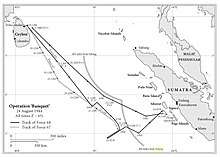Operation Banquet (Padang)
Operation Banquet was a British naval operation in World War II, under the command of Rear Admiral Clement Moody.[1] The objective was to carry out aerial strikes on Japanese positions in and around Padang, on the southwestern coast of Sumatra, Indonesia, on 24 August 1944.[1] The forces involved successfully struck the primary targets of the attack, these being the Padang airfield, the Indaroeng cement works, and the harbor facilities and shipping at Emmahaven.[2][3]
Background
Ships involved in the operation included the aircraft carriers HMS Victorious and HMS Indomitable; battleship HMS Howe, two cruisers, including HMS Cumberland, five destroyers,[1][4] and a single submarine. Indomidable was carrying 28 F6F Hellcat fighters under Lieutenant Commander T. G. C. Jameson and 28 Fairey Barracuda bombers under Lieutenant Commander E. M. Britten. Many of the pilots were inexperienced, and the British hoped that the mission would provide some additional training for them.[5] The plan was to attack Padang airfield, Emmahaven harbour and the Indaroeng cement works. The cement works was the only facility of its kind in South-East Asia. If it was destroyed, the Japanese would be unable to construct fortifications or new buildings in the region.[5] The raid was also supposed to draw away attention from the American landings at Hollandia and Aitape. In addition to this, photographs would be taken for reconnaissance purposes.
The strike force set out from Trincomalee on 19 August. The force delayed for 24 hours so the submarine Sea Rover could replace Severn, which was experiencing technical difficulties. The cruisers and destroyers refueled on 23 August from the replenishment oiler Easedale.
Operation
The strike force arrived at its position at 05:00 on 24 August. There was a light wind coming from the south-east, so the carriers had to launch while steaming at 27 knots (50 km/h; 31 mph). Howe could not keep up and temporarily fell out of formation. The first strike consisted of 20 Barracudas (10 from each carrier) with 500 lb bombs and an escort of 19 Vought F4U Corsairs. The second strike launched at 07:10, consisting of 12 Barracudas (9 from Indomitable, 3 from Victorious) with an escort of 12 Corsairs (from Victorious).[5]

The port and the airfield were never used by the Japanese, and as such there little was allotted to defend them. There was no air opposition, so the bombers had high hit percentages. A single Corsair was shot down by light anti-aircraft fire.[5]
Aftermath
In spite of the accurate bombings, the targets proved to be of little strategic value. The new pilots did not gain much experience either, since they encountered only negligible resistance. The operation failed to draw any Japanese pressure off the Americans at Hollandia. The only notable success was the aerial photography from the Wildcats, which yielded excellent results.[5] The operation "marked the first time the British used a two-wave attack by two fleet carriers."[6]
It came as an unpleasant surprise to the British that the brand new Howe, designed to achieve speeds of 28 knots (52 km/h; 32 mph), could not keep pace with the carriers at 27 knots. In spite of the relatively small distance covered, Victorious consumed about a quarter of her fuel.[5]
Archival footage of the operation held by the Imperial War Museum shows operational takeoffs and landings by Fairey Barracudas, F6F Hellcats, and Vought F4U Corsairs.[7]
References
- Jürgen Rohwer, Chronology of the War at Sea, 1939–1945: The Naval History of World War Two, page 359, 2005.
- Ray Sturtivant, British Naval Aviation: The Fleet Air Arm, 1917–1990, Annapolis, Maryland: Naval Institute Press, 1990, ISBN 0-87021-026-2, pp. 124–125.
- Neil McCart, HMS Victorious, 1937–1969, p. 66, 1998.
- M. J. Whitley, Battleships of World War Two: An International Encyclopedia, page 149, 1999.
- Hobbs, David (2012). The British Pacific Fleet: The Royal Navy's Most Powerful Strike Force (2nd ed.). Seaforth Publishing. pp. 52–54. ISBN 9781783469222.
- H. P. Willmott, Grave of a Dozen Schemes: British Naval Planning and the War Against Japan, 1943–1945, p. 150, 1996.
- OPERATION BANQUET (Allocated), Colonial Film: Moving Images of the British Empire.